Wednesday August 31, 2016
For: Affordability, pliant ride, well-constructed, excellent reputation for reliability.
Against: Requires extra care to shine extra-bright, centre screen under-utilised, CVT can annoy.
Score: 4.2/5
By Richard Bosselman
Corollas: Surely we’ve all known a few?
For me, make it three, or four counting mum’s car, but I’ve driven too many varieties to remember.
You’re probably the same. Chances of there being a Corolla figuring somewhere in everyone’s life stands to reason, this being the biggest-selling nameplate in automotive history. In the story of Corolla ownership, there’s me and 39,999,999 others. And counting …
Toyota these days churns out more models than any other car brand, but even after 50 years Corolla keeps its wheels turning, including in New Zealand, where it faithfully holds station as the brand’s top-selling passenger car.
Only occasionally – such as the GT models (I had two) that ran with the wonderful 4A-GE twin-cammer – could a Corolla be called truly desirable or exciting. For the main part, this is a car that has many sterling qualities, but little if anything that makes it truly outstanding. Corollas trade on competence, dependability and value. They’re not unpleasant, but they’re also … well, orthodox.
That low-key mantle kinda suits with a newly-landed model that potentially does qualify for landmark status. The special something about the $38,490 Corolla Hybrid is wholly explained by its name; this car allows Kiwis to experience their favourite drive with the drivetrain from the world’s top-selling hybrid car, the Prius.
It’s here because …? Mainly to further ‘normalize’ the hybrid driving experience; as the Camry Hybrid has already done (admittedly, mostly with cab drivers). Also, by repackaging the last generation Prius drivetrain into a standard car is a good recycling programme allows Toyota to present an expensive tech in a more cost-effective manner. Corolla slots neatly between the new Prius has updated significantly in technology and the Prius C.
Style, sophistication
When it first appeared, this generation Corolla made something of a scene with its thrusting nose and seriously chiseled lines; it represented a real breakaway from convention toward conservatism.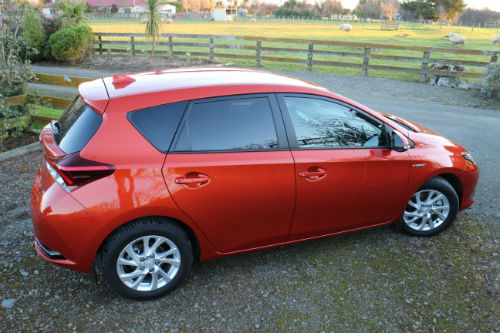
It’s less of a breakaway from now simply because all competitors have increased their visual drama, but continued kudos to Toyota for some impressive detailing, like how those headlamps blend into the grille.
Even so, the most eye-catching single factor associated with this particular car was its colour, a metallic orange appropriately called ‘Inferno.’ Bright colours certainly suit the Corolla – there’s a really vivid blue that is even more flattering – and probably serve to sort the private buyer base from the fleet operators, who still seem to favour white.
The irony of such a bold hue isn’t lost given that the model’s major mission statement is to actual normal; blending in with the crowd to a degree that the dweeby Prius simply cannot hope to. By transplanting a Prius drivetrain into this setting Toyota has set out not just to make battery-assisted tech more affordable but to also show this isn’t such strange science.
Styling signposts to it being the first Corolla to use a battery for more than getting the motor started and firing up the lights and air con are minimized; this derivative has its own unique wheel styling and also has ‘Hybrid’ badges on the flanks and the boot; the canny-eyed might also note that the grille logo has a blue tinge, as per all the other petrol-models.
All Corollas now employ constantly variable transmission technology – which means band drive rather than whirring cogs – and that’s also always been the case with all of Toyotas hybrid cars. Actually, the CVT here is different to the standard car’s and operation also differs; as with Prius, it swaps a regular gearstick for with a small joystick style lever that can be operated with just two fingers, with a ‘Brake’ regenerative mode.
Look at the instrument cluster and you’ll see that in place of a tachometer there’s an economy/performance gauge; basically a snazzier kind of vacuum gauge for anyone old enough to remember those. Erm …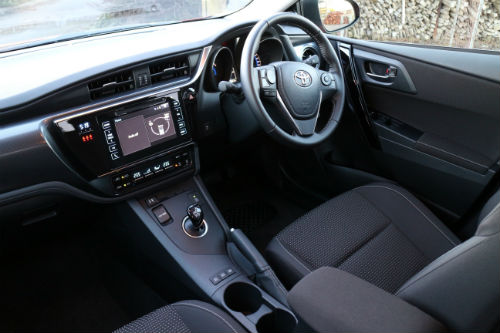
The needle moves between different quadrants depending on how the car is operating; it’s in the blue zone when you're charging the nickel metal-hydride batteries through braking or deceleration, lifts into the green when you're using the throttle in an optimum-eco manner and, if you push too heavily, loses no time to race up into the white – which really should be red, because it’s a danger zone, reminding that you’re using too much oomph for no eco-gain.
The central seven-inch touch screen also reaches beyond the infotainment opportunities afforded in regular Corollas, with many of the same sort of dedicated displays showing energy usage and recuperation that entertain, challenge and – in respect to the bar graph showing recent economy – confuse Prius users. Likewise, there’s another small LCD display, between the main dials of instrument panel, also given over to this.
The cabin treatment overall, though, is similar to that you’ll see in the $3000 cheaper GLX petrol, with the same cloth and plastics that, though undoubtedly chosen foremost for their durability, still look nice. The cabin doesn’t have quite the same degree of quality you’ll see from some European and Korean rivals, but it’s easy to fathom. Visibility is okay but you’ll be pleased it has a reversing camera, even though quality is not great.
Compared with the GLX, the hybrid adds bi-LED headlights with self-levelling, keyless entry (as per the top-line Levin models), extra steering wheel-mounted controls - for that information display in the main instrument cluster - and automatic dual-zone air conditioning.
It’s a pity the hybrid doesn’t get the GLX’s seats; the driver’s chair is poorly shaped and squishy. Ironically, we more recently had opportunity to sample a Corolla Fielder wagon with a hybrid drivetrain – a car TNZ delivers as an ex-Japan choice - and thought the driver’s seat in that car was immensely better (which betrays the notion that export market cars are always better-sorted and provisioned).
Drivetrain
One thing about Toyota; they’re rarely wasteful. We’re into the fourth generation of Prius and each step up has delivered progressively advanced drivetrains.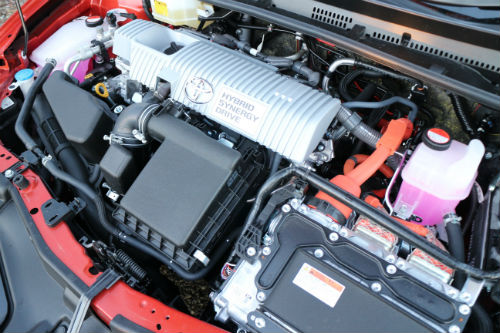
Rather than simply being junked, the powerplants that are left behind are instead ‘re-lifed’, which means we now have three generations of Prius drivetrain operating on NZ roads: the latest in the new model, the previous Prius example in this Corolla and, in the Prius C, the type that ran in the gen 2 car.
That’s brilliant recycling that pushes down the price – so opens the opportunity to more buyers – and also allows Toyota to progress rapidly and effectively toward achieving a core aim of radically reduce carbon dioxide emissions and having 15 million of its hybrids on the road by 2020, double the present tally, and to reduce its new vehicle CO2 emissions by 90 percent from 2010 levels by 2050.
The powertrain here uses a 1.8-litre petrol four producing 73kW/142Nm in marriage with a hybrid system with Nickel Metal-Hydride batteries producing total petrol/electric output of 100kW/142Nm. Toyota’s reluctance in giving a combined torque figure for its petrol-electrics continues here. No inkling of what it might be is provided.
Low emissions is the hybrid tech ace card, but NZ doesn’t care about those, just the next best thing, economy. On official figures, the cited 4.1 litres per 100km means the Corolla is third in frugalness within the Toyota hybrid family, bettered by the latest Prius – which gets down to 3.4L/100km – and the one-size smaller Prius C, which achieves 3.9L/100km from the gen two Prius drive set. For the record, I saw 5.7L/100kms after a week of mixed urban and open road driving, including a 120km highway stint.
Toyota reckons that, by clocking 15,000km per year, you'll save $2500 in fuel cost alone compared with the GLX over five years. Ironically, the initial pump cost works out the other way as the hybrid requires more expensive 95-octane fuel, whereas the GLX can run on 91.
What is obvious is that the financial benefits are largely determined from where you drive it most; at open road speed, hybrids are basically just petrol cars hauling a largely inert battery load. Whereas the power spread around town is far more balanced.
Driving
As is typical of hybrids, you tend to move off (and reverse) in complete silence – on electric power – and the lack of noise requires extra care in in crowded areas, such as supermarket carparks, as pedestrians are often oblivious.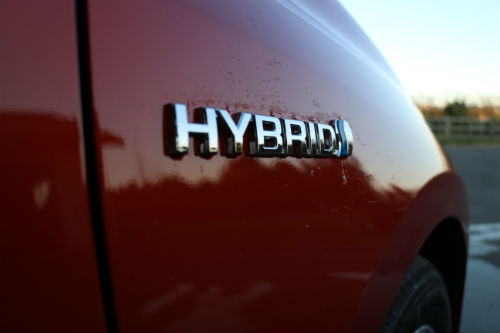
How far and how fast it can go on electric thrust is a challenge that’s really not worth getting all wound up about. In theory, the Corolla is supposedly capable of reaching at least 50kmh on electric and it even has a specific button-operated mode, but while that prioritises this function, it’s not a lock-in and the engine is aching to break in.
To be fair, maybe either I’d recalibrated or the car had, because it seemed easier to drive on electric – for short periods – on test than it seemed to on the launch drive. But it’s not an easy function. Basically a minor ascent or a slight leg twitch can ruin the moment. When you put your right foot down firmly, the engine will of course instantly intercede. If you do manage to keep it drawing consistently off the battery – and it really requires a pendant’s right foot – then you could achieve a couple of kays running, but that’s at very best.
This sort of operation is enough of a balancing act that, for normal town work, the next-step eco mode is ideal, giving you the best combination of performance and economy. There’s also a power mode, that’s about performance of course, not the electrical kind. Realistically, hitting the 190kmh top speed is missing the point.
Whether you are on electric or petrol, the Corolla is a reasonably quiet operator, with just a bit of shrill whining around low speed.
Off-the-line get up and go isn’t a priority, but it doesn’t do too badly: The claimed 0-100kmh time of 10.9 seconds is just under 1s slower than you’ll get from the GLX, which isn’t bad given that the battery pack’s weight is enough to be the equivalent of having a permanent adult passenger on board.
The performance, such as it is, is both helped and hampered by the CVT, which in this instance has a seven-step pseudo-manual opportunity. A calibration that prevents flaring at the top end is a good idea, but as is typical of this tranny type, when you bury the accelerator pedal away from the mark the subsequent frantic leap in engine revs seems totally at odds with relatively leisurely increase in road speed.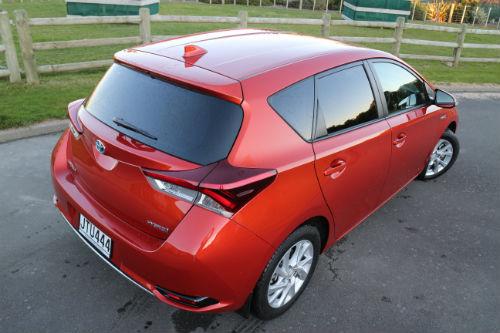
To be fair, it’s only really sprints away from the lights where this trait is fully exposed, and once you're above 60kmh, where you’re less inclined to demand full load from the engine, additional acceleration comes on relatively strongly and in a more hooked-up fashion.
One of the surprise strengths of this Corolla is that it rides and handles quite well. Because Toyota wanted to house the hybrid batteries without sacrificing boot space, the Corolla's old-school torsion beam rear suspension has also been dropped in favour of a more sophisticated double-wishbone arrangement at the rear, as used in higher-specification Auris (Corolla by another name) models in Europe. The extra weight (all those batteries are under the back seat) also tends to settle it.
Bigger brakes are part of this package, but not for sporting intent: Rather the idea is to create extra regenerative energy and, as such, the stoppers are no different to those in the Prius; extremely sharp and offering limited pedal progression.
There is a firm edge to the suspension when you pass over speed humps or potholes, but on faster roads it smooths out the worst of the lumps impressively, keeping the occupants well isolated. Those Michelin Energy Saver tyres aren’t too bad – they’re quiet and it grips well enough - but the steering is so light that while it’s decently accurate, you rarely, if ever feel involved in the process of driving. That’s not necessarily a black mark – it’s relaxing to drive - but for those who enjoy a decent steer, there are better alternatives.
Verdict
And the title of ‘New Zealand’s best-selling hybrid’ goes to …?
Well, it’ll always be a Toyota, such is the market leader’s dominance of this area, but chances are it will, as the brand believes, be this car. Well, why not?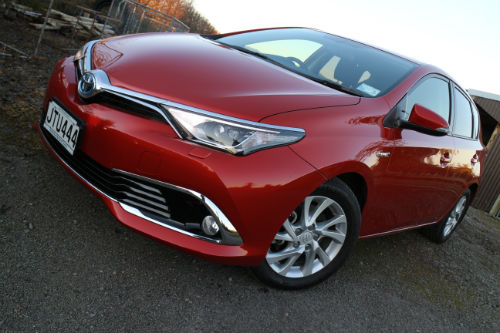
The nickel hydride batteries, planetary gear set, a couple of electric motors that alternate through driving and regeneration modes, depending on the need, is a recipe used by every Toyota hybrid since the very first introduced here, a Prius back in 2003. And yet, arguably, thanks to the realistic pricing and the familiarity of this new setting, it comes of age in this Corolla.
A like-sized diesel car will drive more fluently, but if dynamics are less of a consideration that than positive data then the Corolla evens up really well: The theoretical driving range of about 1100km is diesel-like, it simply cleans up in respect to emissions and, of course, there are no Road User Charges to worry about.


